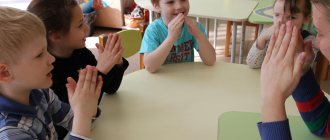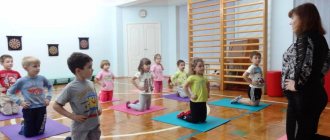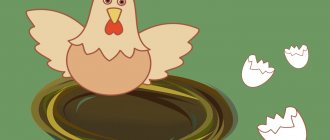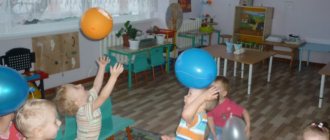Finger games for kids
Finger games have been known almost since ancient times. It is quite possible that they were invented at a time when there were no toys yet, and the only available objects for play were hands. Apparently, the Lord Himself put them in the minds of our ancestors, because this type of games is a unique way of child development.
Finger games, as a rule, have a simple poetic form that is understandable to children, and with the help of hands and fingers, the adult and the child “illustrate” the story. It has long been known what a big role physical contact with a loving adult plays in the development of a child’s personality. Nothing can compare to finger play for the degree of contact that is established during classes. Firstly, babies are usually seated on their laps with their backs facing them. This gives the child a sense of protection from the ring of the mother's embrace. Secondly, all the actions that take place during the game - stroking, patting, bending and straightening fingers help to establish and strengthen trust, develop the child’s communication skills, and finally, this is a huge charge of positive emotions from communication and the game itself.
It has been scientifically proven that children develop intelligence through fine motor skills. The activity of a child’s brain is very closely related to the tactile sensations that the baby receives through his palms and fingers. That is why the best toys for little ones are those that consist of parts of different textures and shapes, allowing the child to understand the difference between soft and hard, hard and tender, smooth and rough. But parents must remember that even the best toy in the world cannot replace personal contact, an eye-to-eye look, or the approving smile of a mother or grandmother. Play with your children! Place them in your arms and discover for them the magical land of finger games.
How should you play with your baby?
— Before the game, briefly explain to your child the essence of the game in an accessible form.
— Play with passion yourself, immerse yourself in the world of your baby.
- Do not give your child a large volume and many tasks at once. Mastering one or two finger games a day is enough.
— Encourage your child’s successes and turn a blind eye to his mistakes.
- The game should bring joy to both of you.
“It happens that the baby suddenly doesn’t like some of the finger games. Don't force him to play it.
Finger games for little ones
Magpie Crow
The adult runs his finger over the child’s open palm and says:
— The magpie-crow was cooking porridge and feeding the children:
(takes one finger at a time, shakes it and bends it towards the palm)
- I gave it to this, I gave it to this, I gave it to this, I gave it to this, but I didn’t give it to this one (swings harder)!
You didn’t go into the forest, you didn’t chop wood, you didn’t light the stove! You have nothing!
* * *
Mushroom fingers
We take the fingers one by one, starting with the little finger, swing each one and press it to the palm:
This finger went into the forest, this finger found a mushroom, this finger began to clean, this finger began to fry.
Well, this one (thumb) - he took it and ate it, and that’s why he got fat!
* * *
Two kids
(On both hands we press the middle and ring fingers with our thumbs).
Once upon a time, a little goat was walking across the bridge to visit someone (Hold your hands horizontally, bring your hands together).
And another one was walking towards him, he was returning home.
(On the first syllable of each line we join our hands in a swing).
* * *
Five ducklings
Five ducklings are swimming forward, their mother is waiting on the shore, (One of the hands - “mother duck” - stands on the table, leaning on her elbow. The fingers are folded in a pinch. The second hand is the ducklings. We perform wave-like movements towards the “duck”. The number of extensions fingers corresponds to the number of ducklings)
But only four ducklings returned to their mother. (fingers gradually bend)
Four ducklings are swimming... Three ducklings are swimming... Two ducklings are swimming... Here one is swimming forward, On the shore his mother is waiting, (To the words “On the shore their mother is waiting” we “nod” with our hand (“mother duck”).
And five ducklings at once
We returned to mommy back.
* * *
Watch
(We sit on a rug or pillow (on our knees). We move our fingers (“run”) from the knees to the top of the head).
The mouse climbed for the first time. See what time it is. Suddenly the clock said: “Bom!” (One clap above the head).
The mouse rolled head over heels. (Hands “roll” to the floor).
The mouse climbed up a second time to see what time it was. Suddenly the clock said: “Bom, bom!” (Two claps).
The mouse rolled head over heels. The mouse climbed for the third time to see what time it was. Suddenly the clock said: “Bom, bom, bom!” (Three claps).
The mouse rolled head over heels.
* * *
Worms
One, two, three, four, five, the worms went for a walk. (Palms lie on your knees or on the table. Bend your fingers, pull your palm towards you (movement of a crawling caterpillar), walk along the table with your index and middle fingers (the remaining fingers are pressed towards the palm).
One, two, three, four, five, the worms went for a walk. Suddenly a crow runs up, she nods her head, (We fold our fingers into a pinch, shake them up and down).
Croaks: “Here comes dinner!” (Open your palm, moving your thumb down and the rest up).
Lo and behold, there are no worms! (Clench our fists, pressing them to our chest)
* * *
In giraffes
Giraffes have spots, spots, spots, spots everywhere. Giraffes have spots, spots, spots, spots everywhere. (Clap your palms all over your body.)
On the forehead, ears, neck, elbows, noses, bellies, knees and toes. (Use both index fingers to touch the corresponding parts of the body.
Elephants have folds, folds, folds, folds everywhere. Elephants have folds, folds, folds, folds everywhere. (We pinch ourselves, as if picking up folds.)
On the forehead, ears, neck, elbows, noses, bellies, knees and toes. (Use both index fingers to touch the corresponding parts of the body).
* * *
Our family
Here is grandpa, here is grandma, here is daddy, here is mommy, here is my baby, and here is the whole family.
Alternately bend your fingers to your palm, starting with the big one, and with the words “Here comes the whole family,” cover the entire fist with your second hand.
* * *
Swing
The branches of the fir trees trembled. We are delighted with the swing. We fly up and down, Have fun with us. (T. Sikacheva) Perform the exercise first with the right hand, then with the left hand, and then with both hands. From the wrist, lift the hands up with straight, closed fingers, and then, slightly bending the fingers, gently lower them down.
* * *
Kittens
(We fold our palms, press our fingers together. Elbows rest on the table). Our cat has ten kittens (We shake our hands without separating them). Now all the kittens are standing in pairs: Two fat, two dexterous, Two long, two cunning, Two small and the most beautiful. (Tap the corresponding fingers against each other (from the big to the little finger).
* * *
Spider
The spider walked along the branch, and the children followed him. (Arms are crossed; the fingers of each hand “run” along the forearm and then along the shoulder of the other hand.)
Rain suddenly poured from the sky, (Brushes are freely lowered, we perform a shaking movement (rain).)
The spiders were washed to the ground. (Clap your palms on the table/knees.)
The sun began to warm up, (Palms are pressed to each other by the sides, fingers are spread out, we shake our hands (the sun is shining)
The spider crawls again, And all the children crawl after it, To take a walk on the branch. (The actions are similar to the original ones, the “spiders” crawl on the head.)
* * *
Bees
A small house on a Christmas tree, a house for bees, where are the bees? You need to knock on the house, (One of the hands stands on the table, leaning on the elbow, fingers spread out (Christmas tree). On the second hand, the fingers close into a ring (beehive). The “beehive” is pressed to the “Christmas tree.” Children look into the “beehive”).
One two three four five. I knock, knock on the tree, (Clench our fists. We knock our fists against each other, alternating hands).
Where, where are these bees? They suddenly began to fly out: (We spread our hands, spread our fingers and move them (the bees fly).
One two three four five!
* * *
Glove
The cheerful mouse found a glove, (Open your palm, fingers spread (glove). Turn your hands either palm or back side up).
Having made a nest in it, (We fold our hands into a “bucket”).
She called the mice. (We bend and straighten our fingers (“calling” gesture).
I gave them a crust of bread to bite (with the tip of my thumb, we tap the tips of the other fingers one by one).
She stroked (spanked) everyone (with our thumb we stroke (“slap”) the rest (with a sliding movement from the little finger to the index finger).
and sent me to bed. (We press our palms together, put them under our cheeks (sleep).
* * *
Piglets
(The fingers are spread out; we alternately “walk” along the table or knees with each of the fingers).
This fat piglet was wagging his tail all day long, (Little Fingers).
This fat pig was scratching his back against the fence. (Unnamed).
La-la-la-la, lu-lu-lya, I love piglets (“Lanterns”).
La-la-la-la, lu-lu-lya, I love piglets (Clench and unclench our fists).
This fat pig was picking the ground with his nose, (Medium).
This fat pig drew something himself. (Indicative).
La-la-la-la, lu-lu-lya, I love piglets (Clench and unclench our fists).
This fat pig is a couch potato and impudent, (Big).
He wanted to sleep in the middle and pushed all the brothers out of the way. (Clench your hand into a fist, press your thumb inward.)
* * *
“Warm-up”
(We perform imitative movements in accordance with the text).
We nod our heads, shake our noses, and knock our teeth and remain silent for a little while. (Press index fingers to lips).
We'll twirl our shoulders and don't forget about our hands. Let's shake our fingers and rest a little. (Bent down, swing with relaxed arms).
We'll dangle our legs and squat a little, we'll like a leg with a leg and we'll start all over again. (We jump in place to the rhythm of the text. Then the tempo accelerates.)
We nod our heads,... We roll our shoulders,...
* * *
"Snail"
The snail sits in the house, sticking out its horns, and is silent.
(One of the hands is a “flower”. It stands on the table, leaning on the elbow. The fingers are half-bent, spread out. The palm is the cup of a flower. The second hand is a snail. The thumb, middle and ring fingers touch the tips. The index and little fingers are extended forward (snail horns ).
Here is a snail crawling (“The snail” sways from side to side).
Slowly forward. (Crawls forward on the table).
It will crawl onto the flower (“Snail” crawls onto the “flower”).
He will gnaw the petals. (“The snail” alternately clasps the fingers (“petals”) of the second hand (“flower”).
She pulled her horns into her head, (The hand (“snail”) curls into a fist (“retracts her horns”).
She hid in the house and fell asleep. (The second hand (“flower”) closes, hiding the “snail” in the “bud”).
* * *
"Spring"
(We fold our fingers into a pinch. We swing them.)
The woodpeckers are knocking louder and the chickadees began to sing. (Palms are closed in a “bucket”, we raise our hands up, open our palms, the sides remain pressed, fingers spread).
The sun rises early to warm our earth. (Movements are repeated).
The sun rises early to warm our earth. The streams are running downhill, all the snow has melted, (We perform wave-like movements with our hands (fingers straightened, closed, palms turned down).
And from under the old grass (Palms closed like a “bucket”).
The flower is already looking... (The palms open, the sides of the hands are joined, the fingers are open, half-bent (the cup of the flower).
And from under the old grass a flower is already looking (Movements are repeated).
The bell opened (Hands stand on the table, resting on their elbows. Fingers clenched into a fist).
In the shade, where the pine tree is, (Fingers gradually loosen up, freely relaxed (bell cup).
Ding-ding, rings quietly, (We swing our hands in different directions, saying “ding-ding”).
Ding-ding, spring has come. Ding-ding, it rings softly, Ting-ding, spring has come.
* * *
“Hares”
Hands rest on the table or knees, fingers relaxed. In accordance with the text, we lift a pair of fingers of the same name one by one, starting with the thumbs. Ten gray hares Were dozing under a bush, And two suddenly said: “There’s a man with a gun.” Two shouted: “Let’s run away!”, Two whispered, “Let’s be silent!”, Two suggested: “We’ll hide in the bushes!” And two suddenly asked: “Can he do “Bach”?” “Bang” - the hunter shot, (Clap your hands). By pressing the trigger of the gun, (Run your fingers along the table or knees). And ten gray hares took off running.
Based on materials from the site https://www.razumniki.ru/




